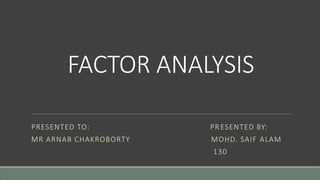
Factor Analysis: Reduce Variables into Fewer Factors
- 1. FACTOR ANALYSIS PRESENTED TO: PRESENTED BY: MR ARNAB CHAKROBORTY MOHD. SAIF ALAM 130
- 2. FACTOR ANALYSIS: Factor analysis is a technique that is used to reduce a large number of variables into fewer numbers of factors. Factor analysis is used to analyse the relationship between two observable variables and how it is affected by another smaller set of unobservable variables. Variable reduction technique.
- 3. Cont. Main focus of the factor analysis is to summarize the information contained in a large number of variables into a few small numbers of factors. The factor analysis allows a researcher to group the variables into a number of factors based on the degree of correlation among the variables. E.g.: Variation in the level of expenditure or savings with variation in the level of income, positive correlation exist.
- 4. EXAMPLE: For example, let's say you wanted to measure people's satisfaction levels in their lives. We'll design a questionnaire that asks several probing questions to determine how satisfied they are. Suppose we ask them how satisfied they are with their hobbies. And suppose we also ask them how intensely they're pursuing a hobby. Most likely, the responses to those two questions would correlate quite highly. We'd therefore be able to conclude that the two questions are redundant, and we can combine the two questions into a single factor. We'd then be able to use the new factor in future data analyses. It's a tactic that leads to better research-and better business intelligence for your company.
- 5. EXAMPLE: For discussion purposes, consider the following five variable data set that is later used for the Factor program. 79652 55462 12345 16523 46525 79665 65321 98653 46521 65435 32165 56523 65454 16589 98965 73195 15937 35079 62486 46428 This data represents the scores (0 to 9 scale) of 20 students on five finals (e.g. Math, English, History, Geography, Science). Can we say that the students’ exam grades in the different subjects are related? The relationship between the student grades is not directly measurable but are, in fact, latent. Grades in different courses could be related because of the student’s intellectual capabilities, memory capacity, or just interest. Although it should be noted that the test grades of one person may not be completely correlated with one another, we can conclude that the grades in all subject areas should depend to some degree on the general intelligence or other factors common to the learning of the subject material. Accordingly, we may identify one or more factors that explain the `common’ portion of the variance in the original raw scores.
- 6. TYPES OF FACTOR ANALYSIS: 1. Exploratory factor analysis: Exploratory factor analysis is used to measure the underlying factors that affect the variables in a data structure without setting any predefined structure to the outcome. It is used in situations where the researcher does not have a hypothesis information. It is used in situations where the unobservable variables are not clear.
- 7. Cont. 2. Confirmatory factor analysis: Confirmatory factor analysis is used as tool in market research and analysis to reconfirm the effects and correlation of an existing set of predetermined factors and variables that affect these factors. Confirmatory factor analysis (CFA) is a statistical technique used to verify the factor structure of a set of observed variables. CFA allows the researcher to test the hypothesis that a relationship between observed variables and their underlying latent constructs exists.
- 8. Cont. 3. Structural equation modelling: Structural equation modelling hypothesizes a relationship between a set of variables and factors and tests these casual relationships on the linear equation model. Structural equation modelling can be used for exploratory and confirmatory modelling alike, and hence it can be used for confirming results as well as testing hypotheses.